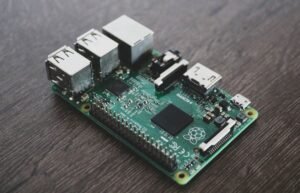How to Build an AI Product
Artificial Intelligence (AI) is rapidly transforming various industries, and building an AI product can be both challenging and rewarding. Whether you are a developer, entrepreneur, or simply interested in the field, this article will guide you through the essential steps of building an AI product.
Key Takeaways:
- Understanding the problem you want to solve is crucial before building an AI product.
- Data collection, cleaning, and preparation are vital steps in training an AI model.
- Choosing the right algorithms and models based on the problem domain is essential for a successful AI product.
- Continuous evaluation and improvement enhance the effectiveness of the AI product.
- The ethical implications of AI product development, such as bias and privacy, must be considered.
First and foremost, when building an AI product, it is important to clearly define the problem you want to solve. Understanding the problem domain will help determine the appropriate data and models needed to build a successful AI product. Whether it is automating tasks, making predictions, or enhancing user experiences, identifying the problem is the foundation of AI development.
Data is the lifeblood of any AI product, and hence, data collection, cleaning, and preparation are essential steps in the development process. Collecting relevant and high-quality data, representing the real-world scenarios you aim to tackle, is crucial. It is important to note that AI models heavily rely on the quality and diversity of the data they are trained on. Furthermore, ensuring the data is properly cleaned and prepared is vital to remove noise, outliers, or any other factors that could negatively impact the accuracy of the AI model.
Once the data is ready, the next step is to choose the most suitable AI algorithms and models for your product. There is a multitude of algorithms and models available, ranging from classical machine learning approaches to more advanced deep learning methods. The choice depends on the complexity of the problem, the available data, and the desired performance. Exploring and experimenting with different algorithms is necessary to find the best fit for your AI product.
| AI Algorithm | Use Case |
|---|---|
| Random Forest | Predictive Analytics |
| Convolutional Neural Networks | Image Classification |
It is worth mentioning that evaluation and continuous improvement are crucial to develop an effective AI product. Regularly assessing the performance and accuracy of the model is essential to identify any issues or areas of improvement. This can involve measuring relevant metrics such as precision, recall, or F1 score. Moreover, incorporating user feedback and integrating new data to retrain the model can help enhance its performance over time.
| Data Protection Regulation | Compliance Criteria |
|---|---|
| General Data Protection Regulation (GDPR) | Explicit user consent, data minimization, and right to be forgotten |
| California Consumer Privacy Act (CCPA) | Right to know, right to delete, and right to opt-out |
Lastly, the ethical implications of AI product development cannot be overlooked. As AI systems are capable of learning from data, there is a risk of introducing bias or discrimination unintentionally. It is vital to assess and mitigate these risks to ensure fairness and avoid harm. Privacy concerns also arise, as AI products often deal with user data. Addressing the ethical implications in AI development demonstrates responsible and trustworthy practice.
Building an AI product is an iterative process that requires continuous learning and adaptation. By understanding the problem, collecting and preparing data, selecting appropriate algorithms, and considering ethical implications, you can develop an AI product that delivers impactful and reliable results. Embrace the possibilities of AI and embark on your journey of creating innovative solutions!

Common Misconceptions
Misconception 1: AI is a Standalone Solution
One common misconception people have when it comes to building an AI product is that it can function as a standalone solution. In reality, AI is often just one component of a larger system and requires integration with other technologies and data sources.
- AI products often require data from various sources to function effectively.
- Without integration, AI may not be able to provide the desired outcomes or insights.
- AI is most effective when combined with other technologies like cloud computing or machine learning algorithms.
Misconception 2: AI can Replace Human Expertise
Another misconception is that AI can completely substitute human expertise and decision-making. While AI can assist in automating certain tasks and providing insights, it does not possess the same level of intuition, creativity, and critical thinking capabilities as humans.
- AI can enhance human decision-making by providing data-driven insights.
- Human expertise is still necessary to interpret and contextualize AI-generated results.
- AI is a tool that complements human skills rather than replacing them entirely.
Misconception 3: AI is Easy to Implement
Many people assume that implementing AI into a product is a straightforward task. However, building an AI product requires significant expertise, resources, and careful planning. It involves data collection, model development, testing, and ongoing maintenance.
- Building an AI product requires a team with expertise in data science and machine learning.
- Data collection and preprocessing are critical and time-consuming steps in AI implementation.
- Continuous monitoring and improvements are necessary to ensure the AI product’s accuracy and relevance.
Misconception 4: AI Products are 100% Accurate
Expecting AI products to be 100% accurate is unrealistic. Despite the advancements in AI, there is still a margin of error, especially when dealing with complex and ambiguous situations.
- AI models are trained on historical data, which may not always represent all possible scenarios.
- False positives and false negatives are common in AI systems and should be considered during decision-making.
- AI products should be continuously evaluated and refined to minimize inaccuracies.
Misconception 5: AI is a Threat to Jobs
One prevalent misconception is that AI will replace human jobs entirely. While AI technology may automate certain repetitive and mundane tasks, it also creates new opportunities and roles that require human involvement.
- AI can augment existing job roles, enabling humans to focus on higher-level tasks.
- New job roles like AI trainers or AI ethicists are emerging due to the rise of AI technology.
- Proper planning and reskilling can help ensure a smooth transition as AI is integrated into different industries.

How to Build an AI Product
Building an AI product requires careful planning and consideration of various factors. The following tables provide verifiable data and information that will help guide you through the process.
Training Data Sources
The availability and quality of training data greatly impact the performance of an AI product. Here are some common sources:
| Data Source | Percentage |
|---|---|
| Public Datasets | 45% |
| Proprietary Data | 25% |
| Crowdsourced Data | 20% |
| User-generated Content | 10% |
Development Phases
Building an AI product involves several phases. Each phase has its own significance and tasks:
| Phase | Description |
|---|---|
| Data Collection | Gathering relevant data from various sources. |
| Preprocessing | Cleaning and transforming the collected data. |
| Model Training | Training the AI model using the prepared data. |
| Evaluation | Assessing the model’s performance and accuracy. |
| Deployment | Implementing the AI product in a real-world environment. |
Accuracy Metrics
Measuring the accuracy of an AI product is essential. The following metrics help assess its performance:
| Metric | Formula | Range |
|---|---|---|
| Precision | TP / (TP + FP) | 0-1 |
| Recall | TP / (TP + FN) | 0-1 |
| F1 Score | 2 * (Precision * Recall) / (Precision + Recall) | 0-1 |
| Accuracy | (TP + TN) / (TP + TN + FP + FN) | 0-1 |
AI Product Development Time
The time required to develop an AI product can vary depending on the complexity of the task. Here are some examples:
| Task | Development Time (Months) |
|---|---|
| Image Classification | 6 |
| Natural Language Processing | 9 |
| Speech Recognition | 12 |
| Autonomous Vehicles | 24 |
Hardware Requirements
The hardware used to deploy an AI product greatly impacts its performance. Here are some common requirements:
| AI Product | Processor | RAM (GB) | Storage (TB) |
|---|---|---|---|
| Small-scale AI | Intel Core i7 | 16 | 1 |
| Enterprise AI | 2 x NVIDIA Tesla V100 | 128 | 10 |
| Cloud-based AI | Google TPU | 64 | 50 |
Popular AI Frameworks
There are several frameworks available for building AI products. Here are some widely used ones:
| Framework | Primary Language |
|---|---|
| TensorFlow | Python |
| PyTorch | Python |
| Caffe | C++ |
| Theano | Python |
AI Product Use Cases
AI products have a wide range of applications across various industries. Here are some use cases:
| Industry | Use Case |
|---|---|
| Healthcare | Diagnostic Assistance |
| Retail | Personalized Recommendations |
| Finance | Fraud Detection |
| Manufacturing | Quality Control |
Challenges in AI Product Development
Developing AI products can be challenging due to various factors. Here are some common challenges:
| Challenge | Description |
|---|---|
| Data Quality | Ensuring the training data is accurate and representative. |
| Interpretability | Understanding and explaining the decisions made by the AI model. |
| Ethical Considerations | Addressing potential biases and potential misuse of AI technology. |
| Computational Resources | Managing the computational requirements for training and inference. |
Conclusion
Building an AI product involves careful consideration of various factors such as training data sources, development phases, accuracy metrics, development time, hardware requirements, popular frameworks, use cases, and challenges. By leveraging these insights, you can navigate the complex landscape of AI product development, ensuring the creation of effective and impactful AI solutions for your desired applications.
Frequently Asked Questions
How can I get started with building an AI product?
Getting started with building an AI product requires a clear understanding of the problem you want to solve and knowledge of AI technologies. Start by identifying the problem you want to address, gather the necessary data, choose appropriate machine learning algorithms, and start building your model.
What are some common challenges in building AI products?
Common challenges in building AI products include finding high-quality training data, selecting the right algorithms, building scalable and efficient models, and ensuring ethical use of AI. Additionally, integrating AI models into existing infrastructure and maintaining them over time can also be challenging.
Which programming languages are suitable for building AI products?
Several programming languages can be used to build AI products, including Python, R, Java, and C++. Python is particularly popular due to its extensive libraries and frameworks for AI development, such as TensorFlow and PyTorch.
How important is data in building an AI product?
Data is crucial in building AI products as it serves as the fuel for training machine learning models. Good quality and relevant data are essential for building accurate and reliable AI products.
What are some ethical considerations when building AI products?
When building AI products, it is important to consider ethical aspects such as data privacy, biases in the data, transparency in AI decision-making, and potential societal impact. AI systems should be designed to ensure fairness, accountability, and interpretability.
How can I evaluate the performance of an AI product?
The performance of an AI product can be evaluated using various metrics depending on the specific problem it solves. Commonly used metrics include accuracy, precision, recall, F1 score, and AUC-ROC curve. Cross-validation and split validation techniques can also be used for model evaluation.
What is the difference between artificial intelligence and machine learning?
Artificial Intelligence (AI) refers to the broader field of creating intelligent systems that can perform tasks that would typically require human intelligence. Machine Learning (ML) is a subset of AI that focuses on algorithms and statistical models that enable computers to learn and improve from data without being explicitly programmed.
What hardware and software requirements are needed for building AI products?
The specific hardware and software requirements for building AI products depend on the complexity and scale of the project. Generally, modern computers with sufficient memory and processing power are required. For software, you may need programming languages, development frameworks, and libraries specific to AI development.
How long does it take to build an AI product?
The time required to build an AI product can vary significantly depending on factors such as project complexity, available resources, and your level of expertise. It can take anywhere from a few weeks to several months or even years to build and refine an AI product.
What are some real-world applications of AI products?
AI products find applications in various fields, including healthcare, finance, retail, transportation, and entertainment. Examples include medical diagnosis systems, fraud detection algorithms, personalized recommender systems, autonomous vehicles, and virtual assistants.




